What Is a Cheap DIY Plant Stand and Why Build One?
A cheap DIY plant stand is a simple wooden structure that holds multiple pots and can be built at home for under ₹700 using basic tools. It’s the perfect solution for apartment dwellers who love plants but struggle with floor space. Unlike expensive store-bought options (₹2,000-₹5,000), DIY stands let you customize dimensions, choose your finish, and create exactly what your space needs—all in just 2-3 hours on a weekend afternoon.
Ever walked into your living room and felt overwhelmed by plants scattered across the floor? I’ve been there. As someone managing a small 2BHK apartment in Mumbai, I know the struggle of loving plants but having zero space. Store-bought plant stands cost anywhere from ₹2,000 to ₹5,000, which is honestly ridiculous when you’re just trying to organize a few pots.
Here’s the good news: I built my first cheap DIY plant stand three months ago with zero woodworking experience, spent just ₹485, and it’s still holding strong with eight pots on my balcony. No fancy tools needed—just basic materials from your local hardware store and a willingness to try something new.
In this guide, I’ll show you exactly how to make an indoor plant stand using step-by-step instructions, share four additional free plant stand woodworking plans, and demonstrate how DIY indoor plant stands for multiple plants can transform your space without emptying your wallet.
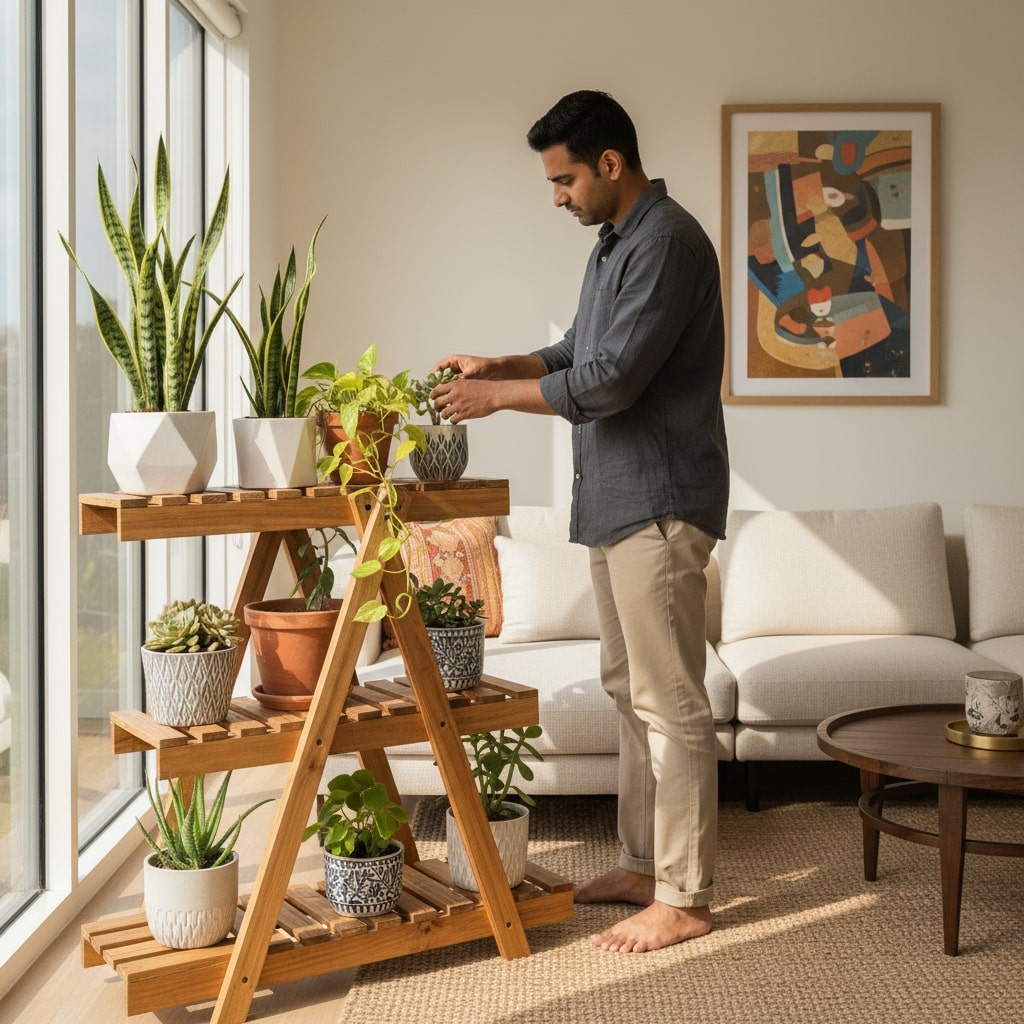
Why I Decided to Build My Own Plant Stand
Saving Money Was Just the Beginning
When I checked prices on Urban Ladder and Pepperfry, decent wooden stands were listed between ₹3,200 to ₹4,800. For what? Four pieces of wood screwed together!
My cheap DIY plant stand cost exactly ₹485 including wood, screws, sandpaper, and varnish. That’s the price of maybe two café coffees in Bangalore—I saved enough for seven weekend outings instead.
The math was simple: either spend ₹3,500 on something generic that might not fit my awkward corner, or invest three hours learning a new skill and getting exactly what I needed.
Customizing for My Weird Apartment Layout
Indian apartments come with their quirks—narrow balconies, odd corners, low ceilings in older buildings. Store-bought options never quite fit.
When you’re making DIY indoor plant stands for multiple plants yourself, you control every dimension. My balcony had a 45cm-wide gap between the washing machine and railing that was completely wasted. Now? Perfect spot for a custom-sized three-tier stand holding six pots.
Before starting this project, I explored several free plant stand woodworking plans online and modified them to suit typical Indian apartment constraints. Once you’ve built your stand, discover which plants thrive in vertical displays to make the most of your new creation.
The Pride Factor (It’s Real!)
Look, I’m not going to pretend building furniture was on my bucket list. But placing that first jade plant on a stand I built with my own hands? Incredibly satisfying.
My wife was genuinely impressed, which doesn’t happen often with my DIY attempts!
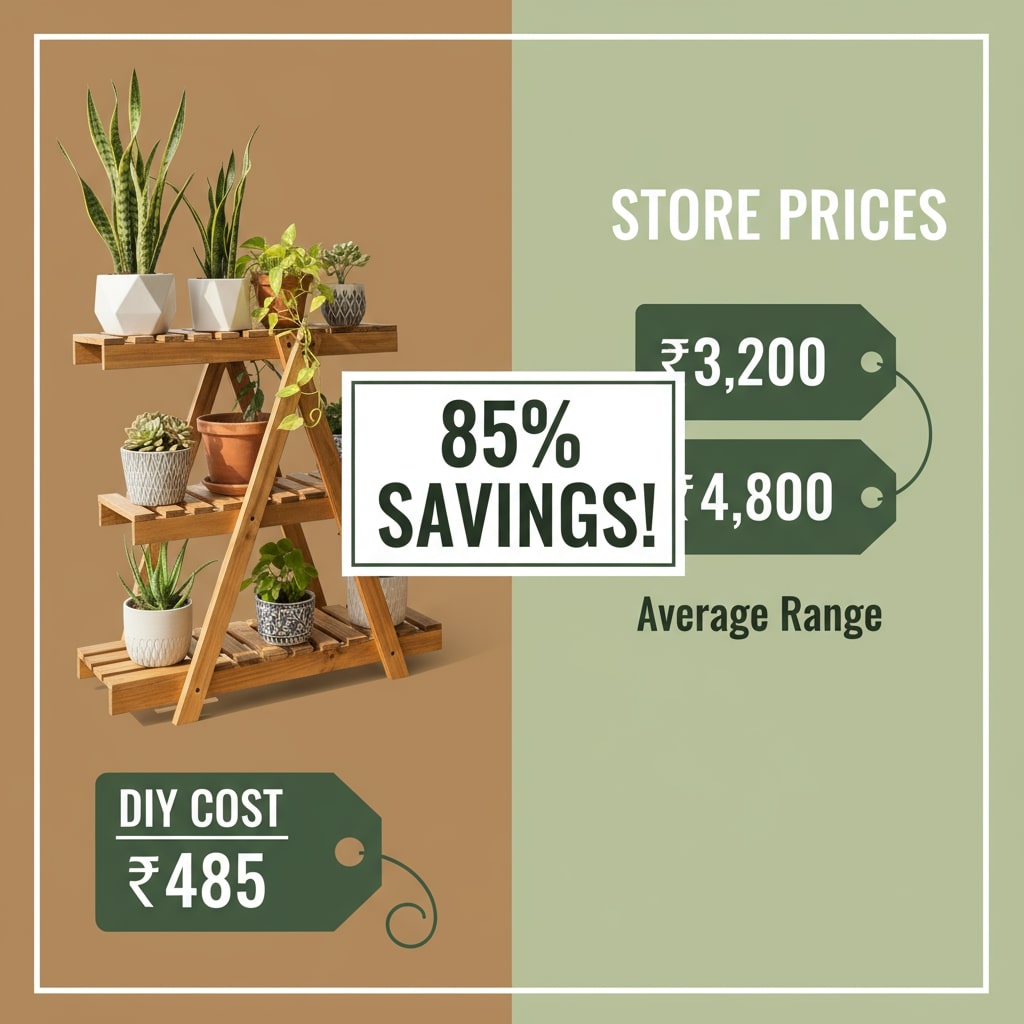
Everything You’ll Need to Get Started (Total Build Time: 2-3 Hours)
Basic Materials (With Real Indian Prices)
Here’s exactly what I bought from my neighborhood timber market in Lal Kuan, Delhi. I initially explored a few free plant stand woodworking plans online before finalizing this design that suits Indian homes perfectly:
- Pine wood planks: 4 pieces, 4 feet × 6 inches × 0.75 inches (₹320)
- Wood screws: 24 pieces, 1.5-inch size (₹45)
- Fevicol Marine wood glue: 100ml bottle (₹95)
- Sandpaper: One sheet each of 120-grit and 220-grit (₹35)
- Wood stain: Small can of walnut brown (₹180)
- Total cost: ₹675 (I already had a drill, which saved money)
For a DIY plant stand indoor wood project, pine works perfectly. It’s affordable, easy to cut, and readily available across India. If you’re planning an outdoor version, ask for treated wood or teak—costs about ₹200 more but handles monsoon rains much better.
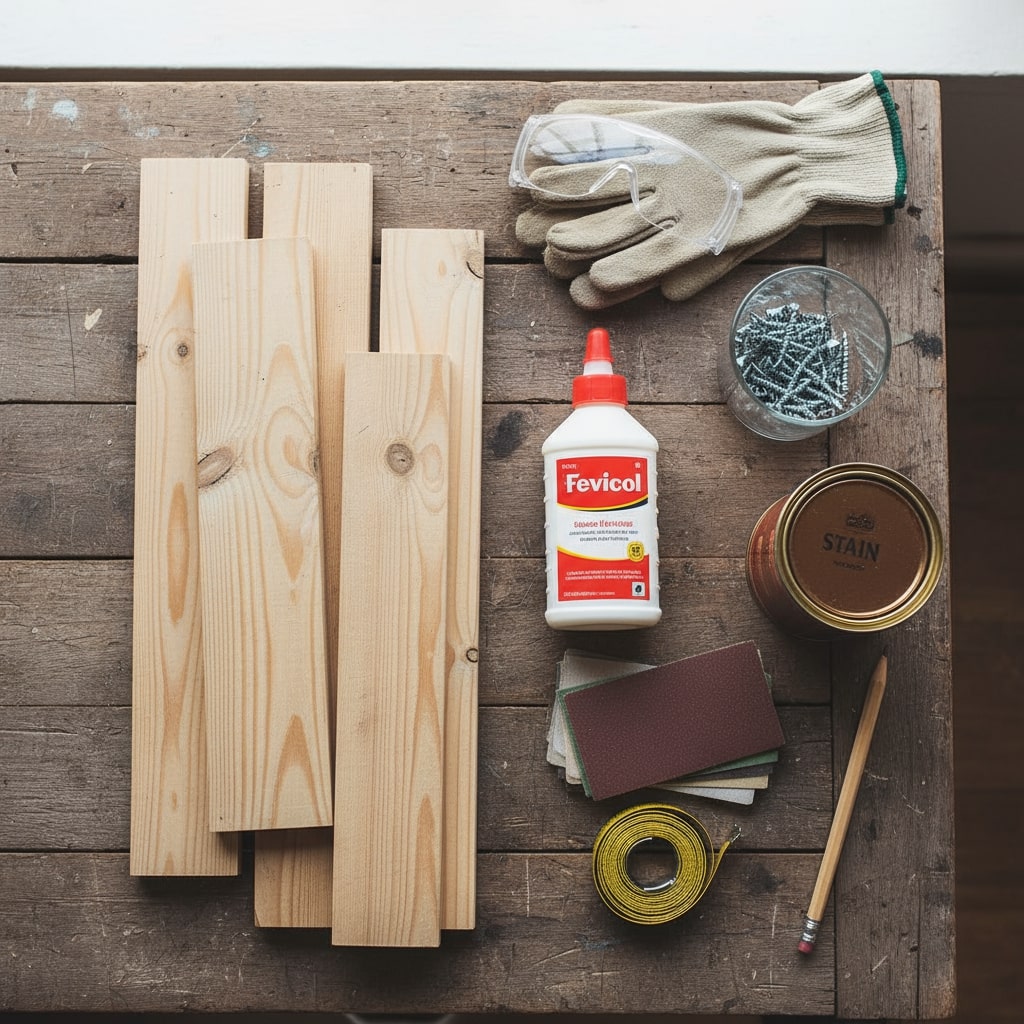
Tools I Used (Borrow What You Can)
- Hand saw (borrowed from my neighbor)
- Cordless drill with bits (₹1,400—but I use it for everything now)
- Measuring tape (₹65)
- Carpenter’s pencil
- Spirit level (₹110)
- Safety gloves and glasses (₹140—don’t skip these!)
⚠️ Safety First: I learned this the hard way—always wear gloves and safety glasses when cutting or drilling. A wood splinter in your eye is not worth the risk. Work in a well-ventilated area, and keep a first-aid kit handy.
Where to Buy Budget Materials
I tried three sources before finding the best deals:
- Local timber markets give the best prices but require some negotiation (Lal Kuan in Delhi, Crawford Market in Mumbai)
- IndiaMART sellers deliver to your doorstep—convenient but slightly pricier
- Amazon/Flipkart for tools with warranties and easy returns
Pro tip: Shop on weekday mornings when timber markets are less crowded. You’ll get better rates and more attention from sellers.
You can find the drill and glue combo I used linked in the affiliate table below.
Trusted Tools That Make Building Easier
This post contains affiliate links. We earn a small commission if you purchase through these links at no extra cost to you.
If you’re starting from scratch like I did, these budget-friendly essentials make the process smoother. I’ve tested each specifically for apartment DIY projects—they’re affordable, beginner-friendly, and most importantly, they actually work.
| Product | Description | Price Range | Why It’s Good | Action |
|---|---|---|---|---|
| Bosch Cordless Drill Kit | Lightweight with 10 bits | ₹1,200–₹1,800 | Essential for every project, 2-year warranty | View on Amazon |
| Fevicol Marine Glue | Water-resistant, Made in India | ₹120–₹180 | Strong bonding for indoor/outdoor stands | View on Amazon |
| Wood Stain Combo | Water-based, eco-friendly | ₹250–₹400 | Multiple colors, moisture protection | View on Amazon |
| Stanley Measuring Set | Professional-grade accuracy | ₹280–₹450 | Perfectly balanced stands every time | View on Amazon |
Ready to transform your plant corner this weekend? Grab these essentials and join hundreds of Indian gardeners who’ve already built their dream displays. Your balcony will thank you!
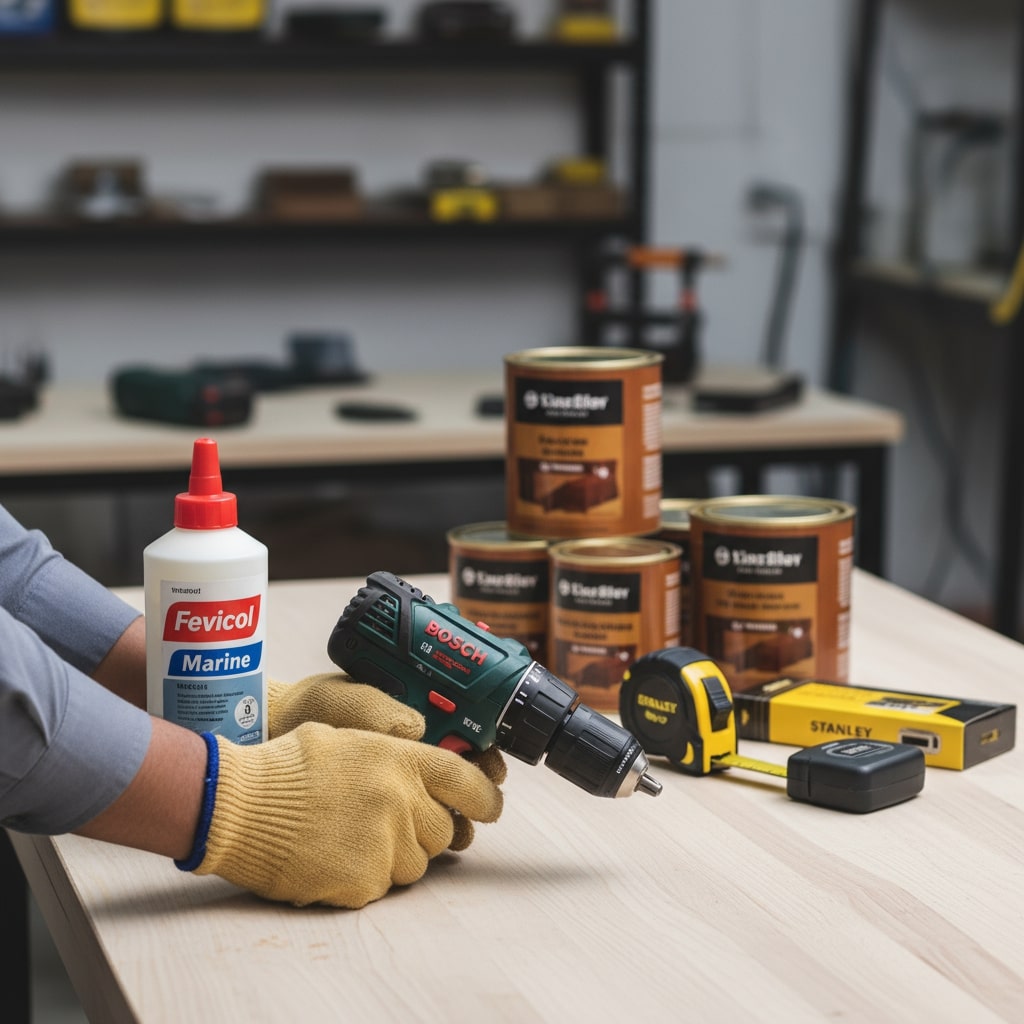
Step-by-Step Guide: How to Make an Indoor Plant Stand (Simple Ladder Design)
This is one of the most popular free plant stand woodworking plans for beginners—simple design, minimal cuts, maximum impact. I chose a 3-tier ladder style that leans against the wall and holds 6-8 small to medium pots. Total build time: 2.5 hours including drying time.
Design Specs:
- Dimensions: 120cm H × 50cm W × 30cm D
- Weight capacity: 15-20kg total
- Difficulty: ★★☆☆☆ (Beginner-friendly)
- Works indoors OR outdoors with proper sealing
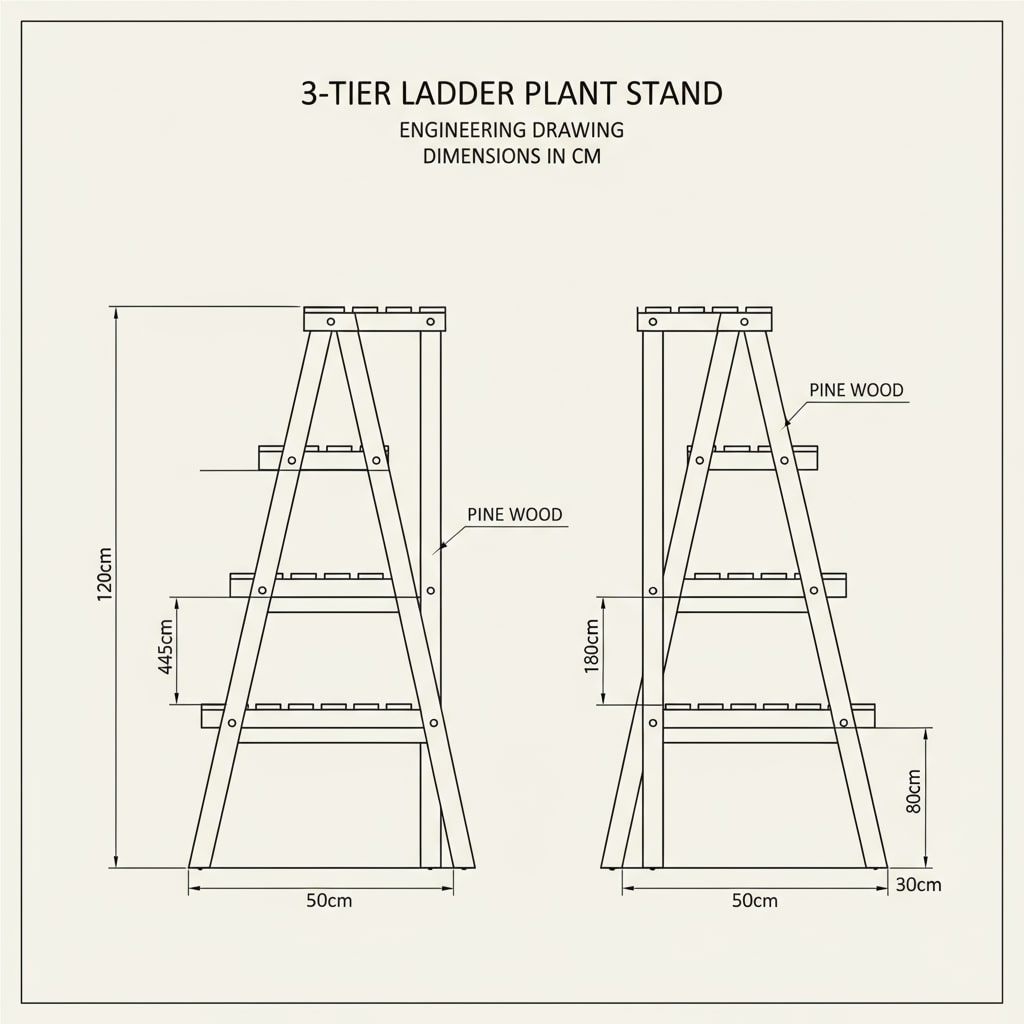
Cutting and Preparing the Wood
Step 1: I measured and marked all cutting lines using a carpenter’s square. The key is measuring twice and cutting once—I learned this after messing up my first piece! You’ll need two vertical supports (120cm each) and three shelf pieces (50cm each).
Step 2: Cutting took patience. I used steady, long strokes with the hand saw, keeping the wood clamped to prevent movement.
💡 Pro Tip: If your wood pieces wobble while cutting, clamp them between two bricks—it’s a simple Indian jugaad that saves time and ensures cleaner edges!
If you don’t have a saw, many local carpenter shops offer cutting services for ₹20-30 per cut.
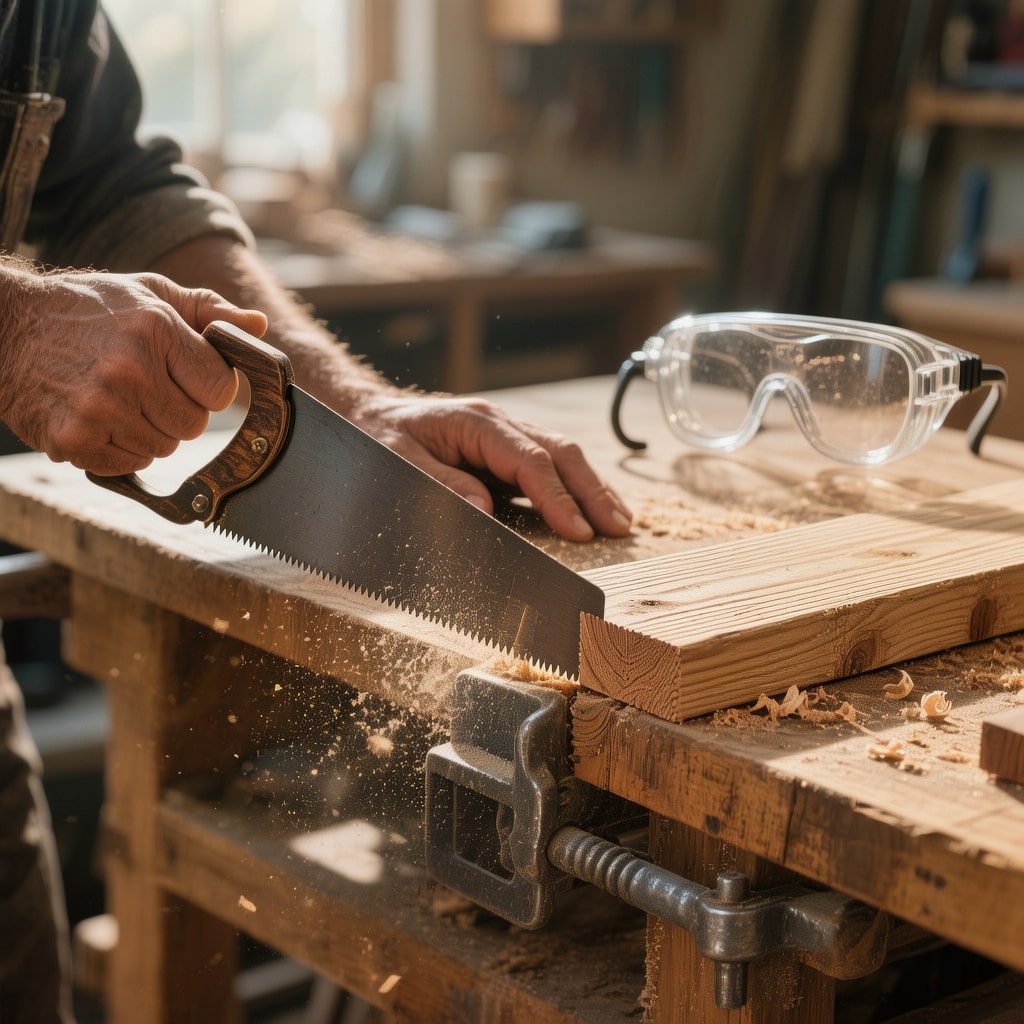
Step 3: Sanding is non-negotiable. I started with 120-grit sandpaper for rough spots, then finished with 220-grit for smooth surfaces. This prevents splinters and helps the stain absorb evenly. Took about 20 minutes for all six pieces.
Progress check: You should now have six smooth pieces ready for assembly—no rough edges, no splinters.
Assembling the Frame
Step 4: I marked shelf positions on both vertical supports. Bottom shelf at 10cm from ground, middle at 45cm, top at 80cm. Used a spirit level to ensure marks were perfectly horizontal on both sides.
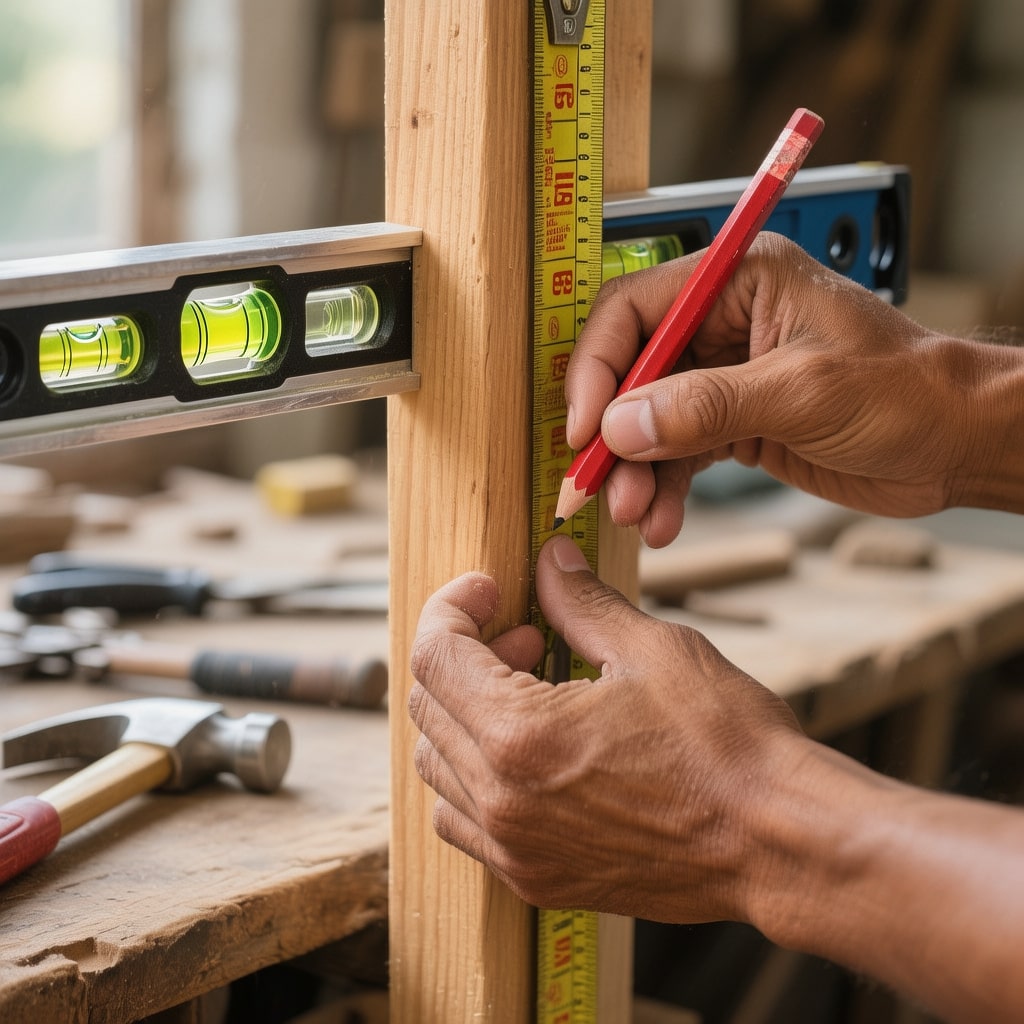
Step 5: Pre-drilling pilot holes prevented wood splitting. I used a drill bit slightly smaller than my screw diameter—two holes per shelf connection point. This step is crucial for learning how to make an indoor plant stand that actually lasts.
Step 6: Applied Fevicol Marine glue to all joints first, then inserted screws while glue was still wet. Used the level constantly to keep shelves horizontal. Wiped excess glue immediately with a damp cloth. The combination of glue and screws creates rock-solid joints—this is the key to understanding how to make an indoor plant stand that won’t wobble after a few weeks.
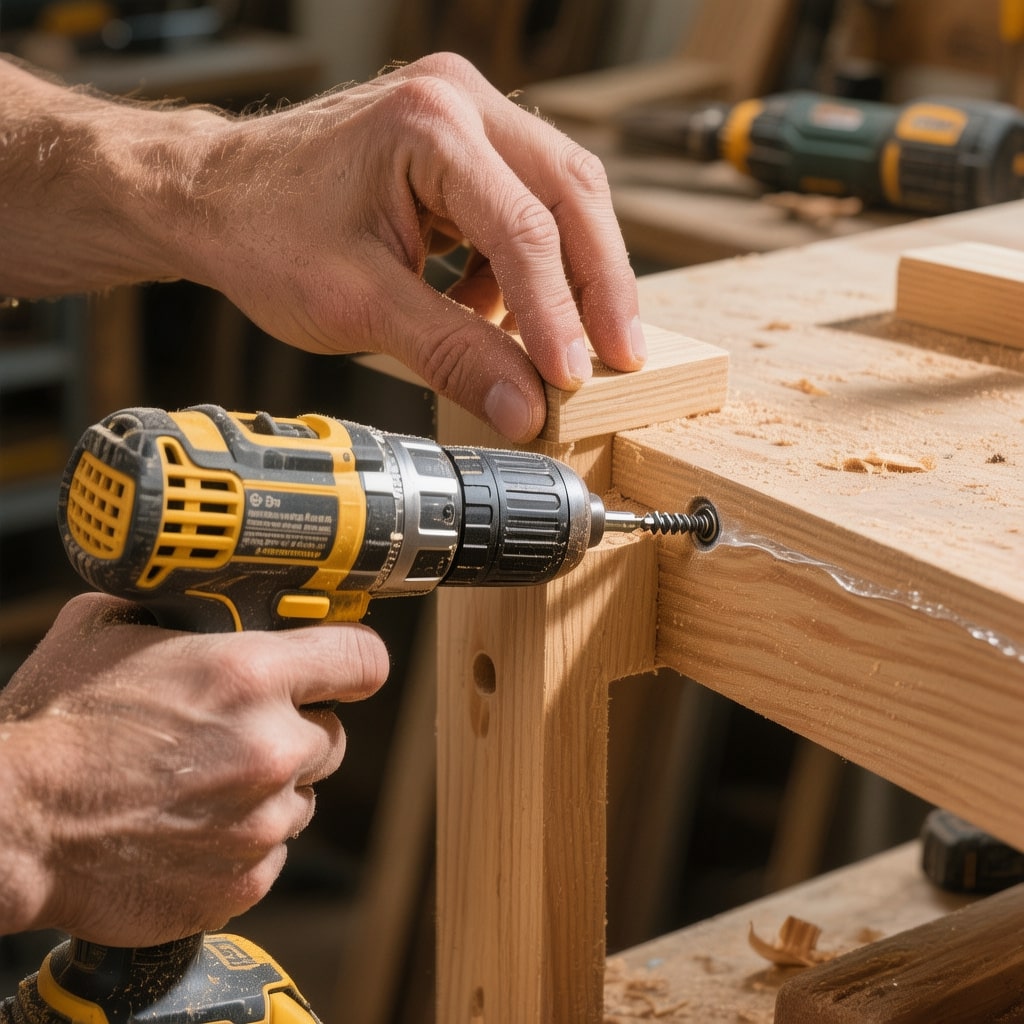
Finishing Touches
Step 7: I added diagonal back braces using leftover wood. Not mandatory, but they prevent wobbling—especially important when holding multiple heavy pots. Just two small pieces screwed at angles between shelves and vertical supports.
Step 8: Applied two thin coats of walnut brown stain using a cloth. Let each coat dry 3-4 hours. Popular color choices for Indian homes include teak stain, natural wood, or matte white paint.
Step 9: Final step—sealing for protection. For my indoor version, I used one coat of water-based polyurethane. For outdoor balcony stands, this DIY plant stand indoor outdoor design needs two coats of marine-grade varnish for weather protection. Let it cure fully for 24 hours before adding plants.
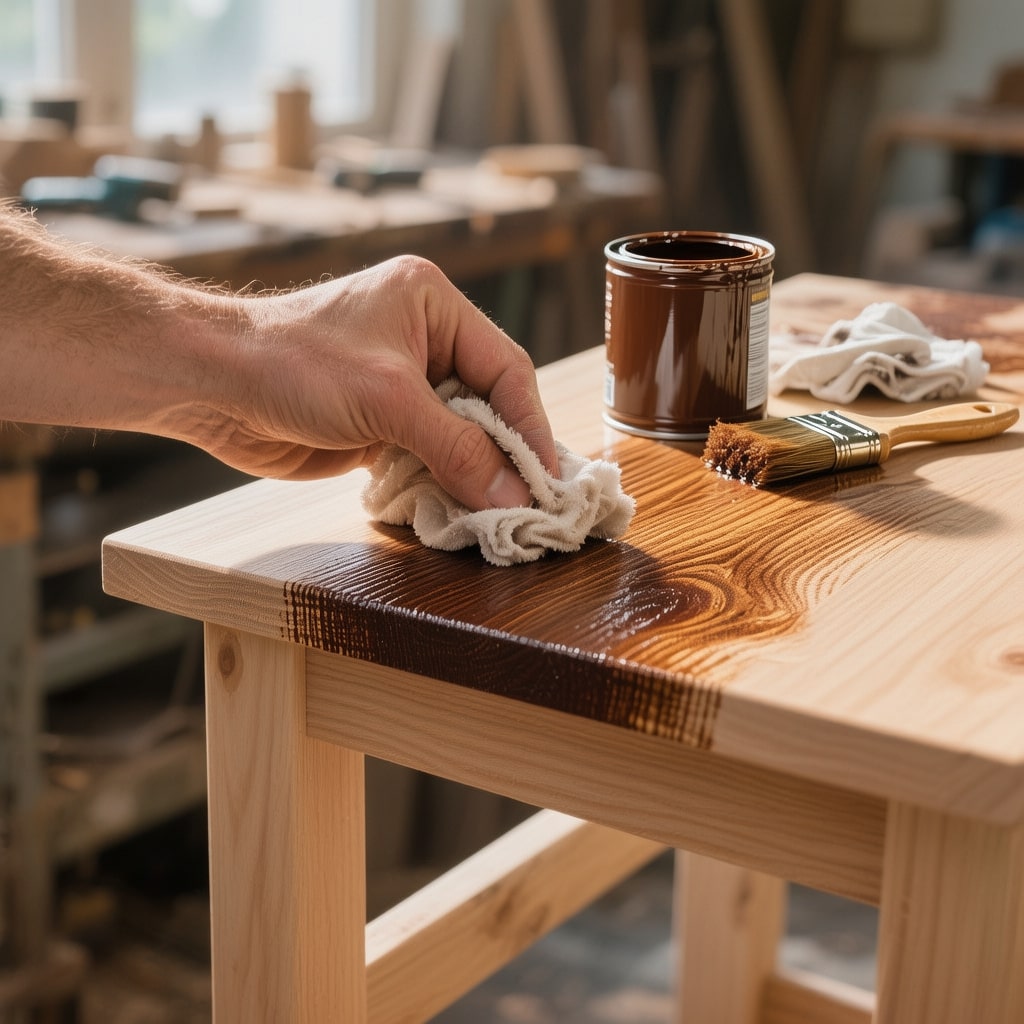
Indoor vs. Outdoor: Key Differences
Since I wanted a DIY plant stand indoor outdoor versatility, here’s what changes:
| Aspect | Indoor | Outdoor |
|---|---|---|
| Wood type | Pine, plywood | Teak, treated wood |
| Finish | Single polyurethane coat | Double marine varnish |
| Drainage | Trays under pots | Drill small holes in shelves |
| Feet | Felt pads | Rubber feet (elevated 1cm) |
Caption: Comparison chart showing indoor vs outdoor finishes
Taking your green thumb outdoors? Learn the complete process of creating a vertical wall garden to complement your new stand beautifully.
Four More Budget-Friendly Designs I’ve Tried
After building my first ladder stand, I got addicted! Here are four additional free plant stand woodworking plans that work beautifully in Indian homes. These DIY indoor plant stands for multiple plants offer variety depending on your space constraints and aesthetic preferences.
Quick Cost-Benefit Overview
| Design | Cost | Build Time | Pots Held |
|---|---|---|---|
| Corner Triangle | ₹350 | 90 min | 4-6 |
| Wall-Mounted | ₹280 | 45 min | 5-7 |
| Repurposed Ladder | ₹120 | 30 min | 6-8 |
| Rolling Cart | ₹850 | 2 hours | 8-10 |
Corner Triangle Stand
Perfect for that awkward corner in every Indian living room. Triangle footprint (40cm × 40cm × 40cm) holds 4-6 medium pots. Cost: ₹350. Build time: 90 minutes. Uses just three wooden boards, six brackets, and twelve screws.
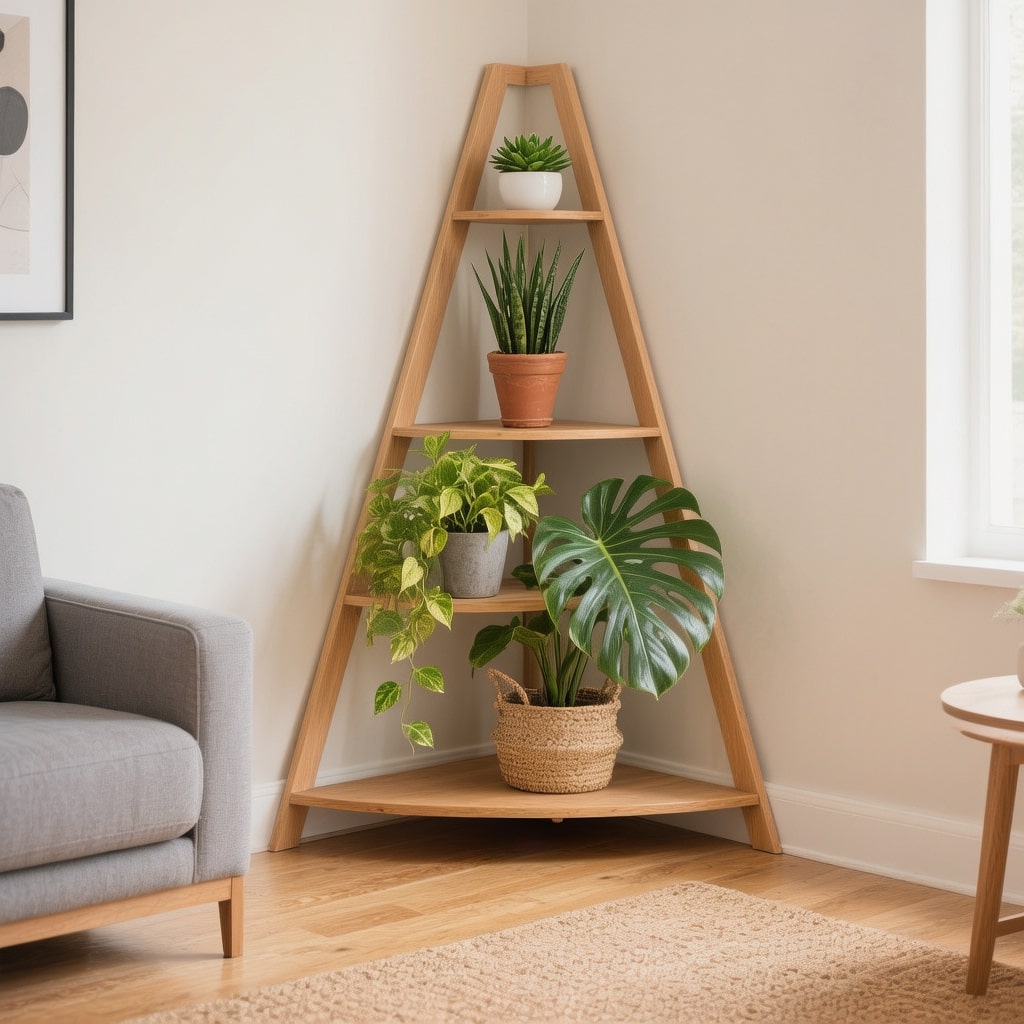
Wall-Mounted Floating Shelves
Zero floor footprint—game-changer for tiny apartments! Three staggered shelves hold 5-7 small pots. Cost: ₹280. Takes just 45 minutes. Works on brick, concrete, or drywall with appropriate anchors. Maximize vertical space by pairing this with DIY hanging planter boxes for a complete living wall effect.
Repurposed Ladder (Zero Cuts!)
Found an old wooden ladder? Simply sand it, paint it, and add small shelf boards across the rungs. Cost: ₹120 (just paint and sandpaper). Perfect bohemian aesthetic. I found my ladder from a construction site nearby—ask your local kabadiwala (scrap dealer).
Rolling Cart with Wheels
Ultimate flexibility for Indian summers—roll plants indoors during harsh afternoon sun. Four shelves on locking casters. Cost: ₹850. Build time: 2 hours. Bonus: works as a bar cart when you’re not using it for plants!
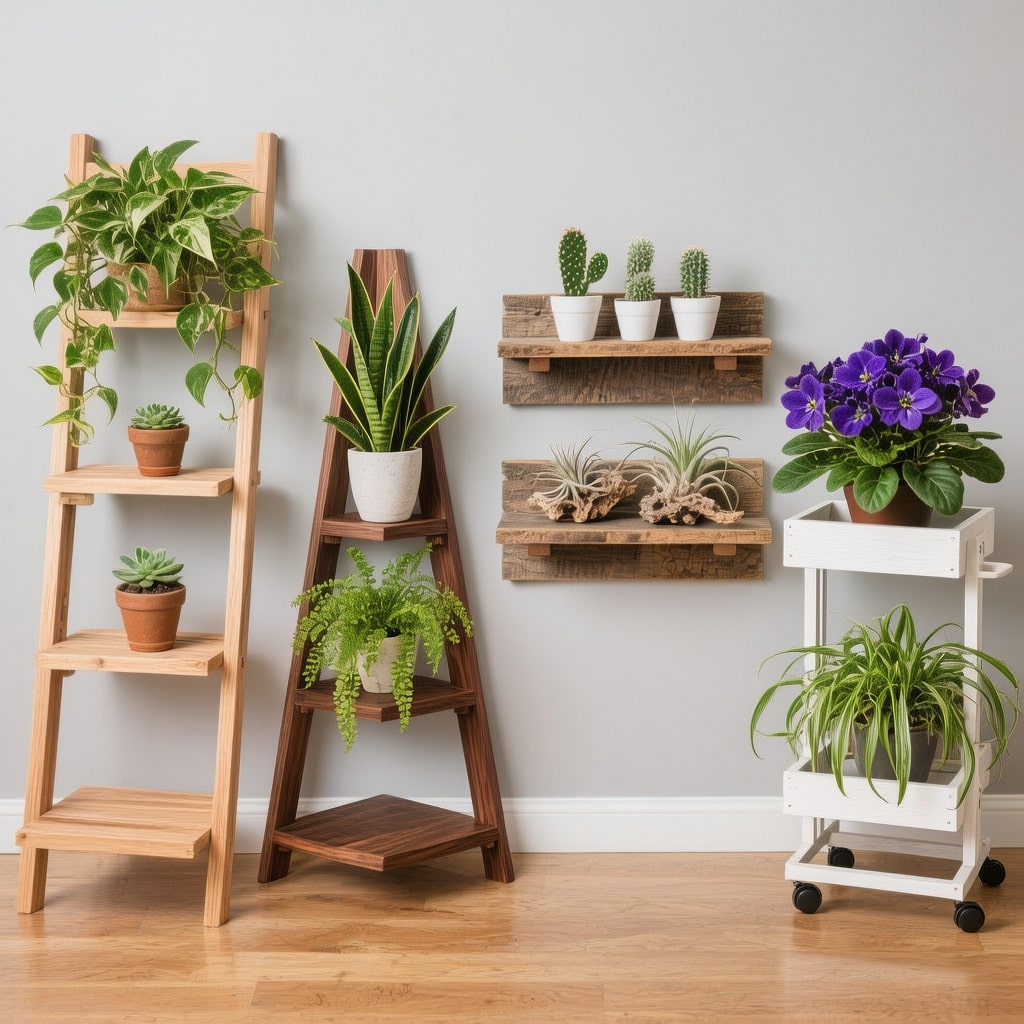
Making Your Stand Look Instagram-Worthy
Building DIY indoor plant stands for multiple plants is half the fun—styling them is where personality shines. Here’s what worked for me:
Plant arrangement tips:
- Place tall plants (snake plants, dracaena) at the back
- Let trailing pothos cascade from front edges
- Group by color or go eclectic (I prefer the messy, lived-in look)
- Indian favorites that work beautifully: money plant, jade, tulsi, aloe vera
- Odd numbers (3, 5, or 7 pots) look more natural
These DIY indoor plant stands for multiple plants work beautifully with wooden finishes that complement Indian décor palettes—warm browns, natural teak tones, and matte whites blend seamlessly with traditional and modern interiors.
Decor elements I added:
- Macramé hangers on the wall behind for depth
- Warm white fairy lights wrapped around edges (creates magical evening ambiance)
- Mixed pot materials—ceramic, terracotta, and metal for texture
Keep your beautiful display vibrant year-round with expert advice from our weekly seasonal gardening tips.
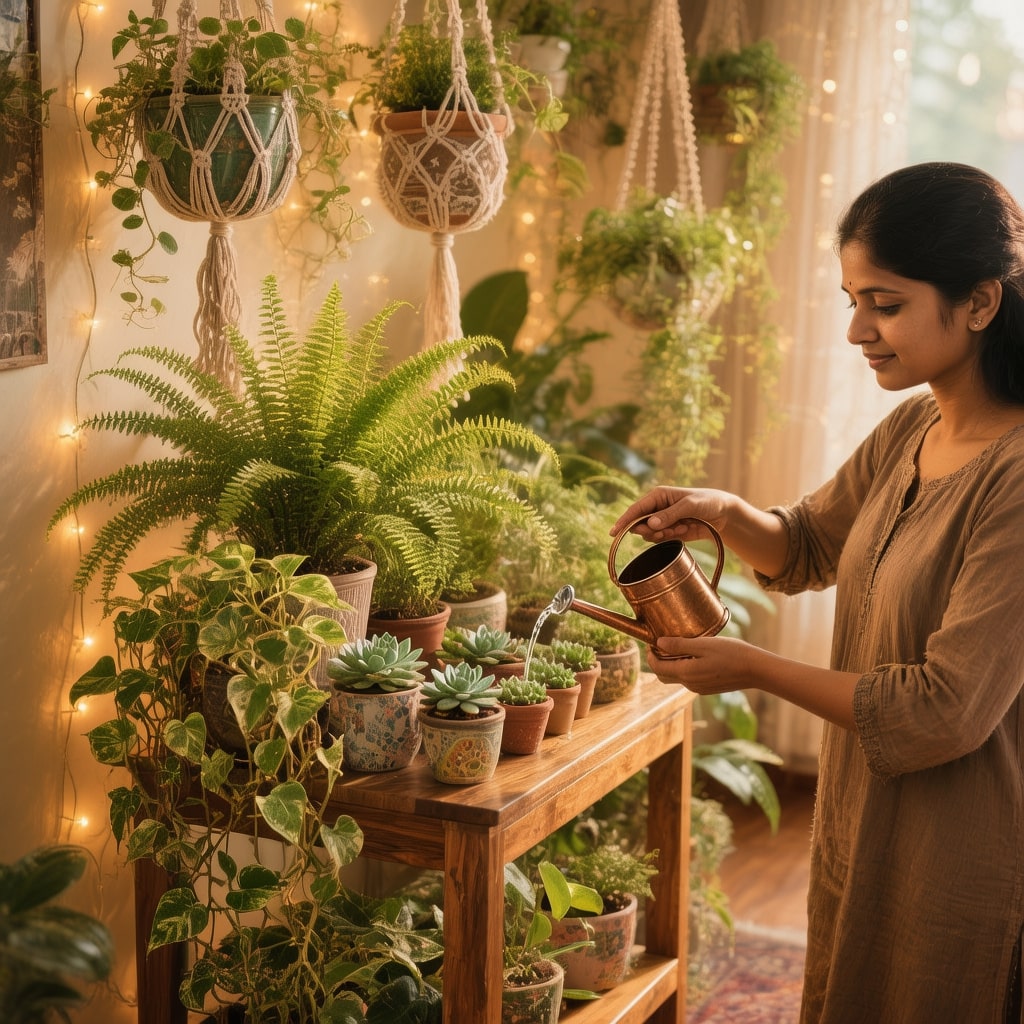
Caring for Your Stand (So It Lasts Years)
My cheap DIY plant stand is still going strong after three months—here’s how I maintain this DIY plant stand indoor wood project:
- Monthly checks: Tighten screws (wood expands/contracts with humidity)
- Water protection: Always use trays under pots—even one spill can warp wood
- Weight distribution: Heaviest pots on lower shelves (top shelf max 3-4kg)
- Cleaning: Dust weekly with dry cloth, deep clean monthly
- Monsoon care: My outdoor stand gets an extra varnish coat before monsoon
With proper maintenance, your cheap DIY plant stand can last 5-10 years—far longer than store-bought alternatives.
According to Gardening Know How, proper wood sealing and regular maintenance can extend DIY furniture life by 3-5 years compared to untreated pieces, making this investment truly worthwhile.
5 Common Mistakes (I Made Some of These!)
- Skipping measurements = wobbly, unsafe stand
- Using unseasoned wood = warps within weeks (buy kiln-dried!)
- Overloading shelves = potential collapse (test with rice bags first)
- Forgetting drainage = water rots wood in months
- Rushing sealing = trapped moisture ruins finish (wait the full 24 hours!)
Following these steps to build an indoor stand correctly means avoiding all these pitfalls.
Frequently Asked Questions About DIY Plant Stands
How much does it cost to build a cheap DIY plant stand?
Most designs cost ₹200-₹800 depending on materials. My ladder stand cost ₹485. Using reclaimed wood can bring costs near zero. Tools can be borrowed to save money further.
What wood is best for DIY indoor plant stands for multiple plants?
Pine and plywood work excellently indoors due to affordability and easy workability. For outdoor/balcony use, choose teak or treated wood for weather resistance. Bamboo is an eco-friendly alternative. Avoid MDF—it disintegrates when wet.
Can I build one without power tools?
Absolutely! Many free plant stand woodworking plans need only a hand saw, hammer, and screwdriver. The repurposed ladder design needs zero cutting. Local carpenter shops offer cutting services for ₹20-50 per cut.
How do I waterproof an indoor/outdoor DIY plant stand?
For indoor stands, apply water-based polyurethane. For outdoor exposure, use marine-grade varnish (two coats) with UV protection. Reapply outdoor sealant annually before monsoon. Let each coat dry 24 hours.
What’s the easiest design for beginners?
The ladder-style stand needs just 4 boards and basic assembly. Takes 2-3 hours total with no complex angles or joints. The repurposed ladder is even easier if available.
Start Building Your Plant Stand This Weekend
Building your own cheap DIY plant stand isn’t just about saving money—it’s about creating something perfectly suited to your space and style. Whether you choose the ladder design, corner stand, or wall-mounted option, you now have everything needed to start this weekend.
The satisfaction of placing your first plant on something you built yourself is genuinely unbeatable. Plus, you’ve gained woodworking skills that’ll serve countless future projects.
Start simple. Take your time. Don’t stress perfection—small imperfections add character. And when you’re done? Share a photo! The Indian gardening community celebrates every success.
Want detailed measurements and cut lists for all 5 designs? Subscribe now and get our complete DIY plant stand blueprint PDF bundle FREE—plus weekly gardening hacks that actually work in Indian climates!
Explore more easy DIY garden ideas on Flat Gardening and start your next project today!
Written by Zaid Ansari — a gardening blogger from India who shares simple, affordable home garden and DIY projects for beginners. With years of hands-on experience in vertical gardening and space-saving solutions, Zaid breaks down complex projects into steps that actually work in real Indian homes. When he’s not building plant stands or tending to his balcony jungle, you’ll find him sharing practical gardening hacks specifically designed for India’s unique climate and space constraints.
Pingback: DIY Plant Pots Indoor Under ₹50 (Step-by-Step!)